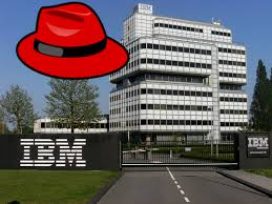IBM Earnings Stress Red Hat Tech, Hybrid-Cloud Partners
IBM (NYSE: IBM) had good and not-so-good news in its second-quarter earnings report yesterday, but investors seem focused on the brighter outlook, raising the share price after hours and in morning trading today.
The company posted $18.1 billion in revenues (nearly $1 billion above Wall Street estimates) and operating (non-GAAP) EPS of $2.18 on net income of $1.9 billion. That revenue figure represents a drop of 5.4% and a 31% reduction in non-GAAP EPS and net income year-over-year. Still, IBM showed improved sales in systems and storage, as well as in cloud-related software, business, and technology services.
“[W]hile the current environment poses certain short-term challenges, it also presents long-term opportunities that IBM will seize, as our clients accelerate their shift to hybrid cloud and AI,” said CEO Arvind Krishna on last night’s earnings call.
IBM's stock barely moved on the news -- falling slight by .31 (.25%) to $126.06.
IBM Stresses OpenShift for Hybrid Cloud
Despite enterprise spending lags in the wake of the COVID-19 crisis, CEO Krishna was specific in outlining what IBM sees as its main market opportunity. “Hybrid cloud is the dominant force driving change in our industry, but it’s far from universal adoption. Only 20% of the workloads have moved to the cloud,” he said.
To grab the 80% opportunity, IBM will focus on selling its hybrid cloud technology, based on Red Hat OpenShift, to large enterprises that require what Krishna called an “interoperable IT environment across on-premise, private, and publicly operated cloud environments, in most cases from multiple vendors.”
IBM also is turning to an expanded partner ecosystem to gain share in hybrid cloud. Krishna pointed to Adobe, as well as strengthened alliances with Salesforce, SAP, Box, and Slack, and with big systems integrators such as Ernst & Young, Infosys, Wipro, Tata Consultancy Services, Tech Mahindra, and Persistent Systems.
IBM’s hybrid cloud focus also aims at emerging multi-access edge computing (MEC) and emerging 5G services. “We launched our new edge and telco network cloud solutions built on Red Hat OpenStack and Red Hat OpenShift that enables clients to run workloads anywhere, from a data center, to multiple clouds, to the edge,” said Krishna. As an illustrative instance, earlier this month IBM announced a partnership with Verizon Business that will build on Verizon’s MEC and 5G capabilities.
IBM Reveals More Details and Plans
IBM improved its dividend and also expanded capital spending — based on unaudited results, IBM grew capex by over 10%. And a surprise came from sales of IBM Z systems, which rose 69% year-over-year. Reportedly, the addition of cloud development tools to these mainframes made them more attractive to enterprise customers.
Big Blue also seems to be taking action against some of its non-tech challenges, including claims that its workforce is bloated. While not making any reference to layoffs last night, CEO Krishna pointedly referred to “simplifying the geographic dimension of our go-to-market by consolidating our operations and moving to a streamlined structure for sales teams” and “transforming key business support functions to simplify our organizational structure.”
IBM still isn’t offering guidance due to the macroeconomic conditions brought about in part by the pandemic. But investors rallied to the positive aspects of the report, the first since Arvind Krishna took the CEO spot in April. At press time, IBM shares were up to 127.10 USD +0.62 (0.49%).





